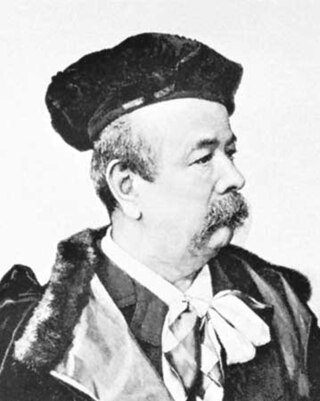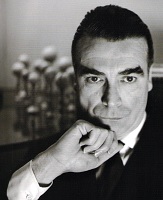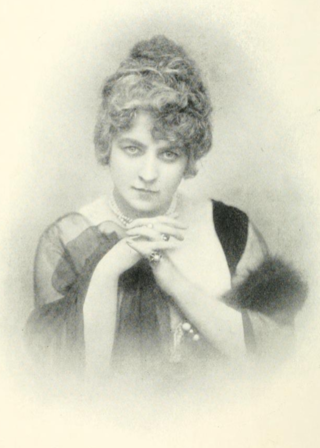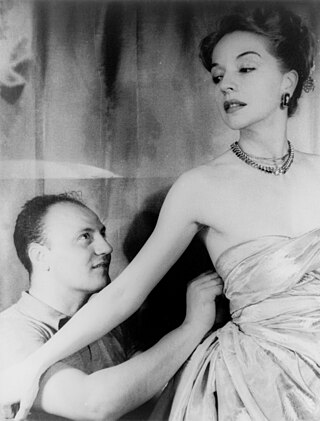
Count Hubert James Marcel Taffin de Givenchy was a French aristocrat and fashion designer who founded the luxury fashion and perfume house of Givenchy in 1952. He is famous for having designed much of the personal and professional wardrobe of Audrey Hepburn and clothing for Jacqueline Bouvier Kennedy. He was named to the International Best Dressed List Hall of Fame in 1970.

Charles Frederick Worth was an English fashion designer who founded the House of Worth, one of the foremost fashion houses of the 19th and early 20th centuries. He is considered by many fashion historians to be the father of haute couture. Worth is also credited with revolutionising the business of fashion.

Jean Patou was a French fashion designer, and founder of the Jean Patou brand.

Cristóbal Balenciaga Eizaguirre was a Spanish fashion designer, and the founder of the Balenciaga clothing brand. He had a reputation as a couturier of uncompromising standards and was referred to as "the master of us all" by Christian Dior and as "the only couturier in the truest sense of the word" by Coco Chanel, who continued, "The others are simply fashion designers". On the day of his death, in 1972, Women's Wear Daily ran the headline "The King is Dead".

Hanae Mori was a Japanese fashion designer. She was one of only two Japanese women to have presented her collections on the runways of Paris and New York, and the first Asian woman to be admitted as an official haute couture design house by the Fédération française de la couture in France. Her fashion house, opened in Japan in 1951, grew to become a $500 million international business by the 1990s.

Roger Maurice Louis Bohan was a French fashion designer, best known for his 30-year career at the house of Dior.
Givenchy is a French luxury fashion and perfume house. It hosts the brand of haute couture and ready-to-wear clothing, accessories, perfumes and cosmetics of Parfums Givenchy. The house of Givenchy was founded in 1952 by designer Hubert de Givenchy and is a member of Chambre Syndicale de la Haute Couture et du Prêt-à-Porter. It is currently owned by luxury conglomerate LVMH.

Lucien Lelong was a French couturier who was prominent from the 1920s to the 1940s.

Jeanne Paquin (1869–1936) was a leading French fashion designer, known for her resolutely modern and innovative designs. She was the first major female couturier and one of the pioneers of the modern fashion business.

Paris Fashion Week is a series of designer presentations held semi-annually in Paris, France, with spring/summer and autumn/winter events held each year. Dates are determined by the Fédération de la Haute Couture et de la Mode. Paris Fashion Week is held at venues throughout the city.

Haute couture is the creation of exclusive custom-fitted high-end fashion design. The term haute couture is French, "haute" meaning "high" or "elegant," and "couture" translating to "sewing" or "dressmaking." The term haute couture generally refers to a specific type of upper garment common in Europe during the 16th to the 18th century, or to the upper portion of a modern dress to distinguish it from the skirt and sleeves. Beginning in the mid-nineteenth century, Paris became the centre of a growing industry that focused on making outfits from high-quality, expensive, often unusual fabric and sewn with extreme attention to detail and finished by the most experienced and capable of sewers—often using time-consuming, hand-executed techniques. Couture translates literally from French as "dressmaking", sewing, or needlework and is also used as a common abbreviation of haute couture and can often refer to the same thing in spirit.
Madame Grès (1903–1993), also known as Alix Barton and Alix, was a leading French couturier and costume designer, founder of haute couture fashion house Grès as well as the associated Parfums Grès. Remembered as the "Sphinx of Fashion", Grès was notoriously secretive about her personal life and was seen as a workaholic with a furious attention to detail, preferring to let her work do the talking. Grès, best known for her floor-length draped Grecian goddess gowns, is noted as the "master of the wrapped and draped dress" and the "queen of drapery". Grès's minimalistic draping techniques and her attention to and respect for the female body have had a lasting effect on the haute couture and fashion industry, inspiring a number of recent designers.
François Lesage was a French couture embroiderer. Lesage was globally known in the art of embroidery and worked for the largest fashion and haute couture houses. His atelier is now part of Chanel through the company's subsidiary, Paraffection.
Antonio Cánovas del Castillo de Rey, known professionally as Antonio Castillo, was a Spanish fashion and costume designer. In a career spanning over three decades, he is recognized for his prolific work across stage and screen, as well as fashion. He won the Academy Award for Best Costume Design, which he shared with Yvonne Blake for their work on Franklin J. Schaffner's epic period drama film Nicholas and Alexandra (1971).
Ulyana Viktorovna Sergeenko is a Kazakhstani and Russian fashion designer.
Emmanuelle Khanh was a French fashion designer, stylist and model. She was particularly known for her distinctive outsize eyewear, and was considered one of the leading young designers of the 1960s New Wave movement in France.
Philippe Venet was a French fashion designer.
Gustav Zumsteg was a Swiss art collector, silk merchant and restaurateur. He was the owner of the restaurant Kronenhalle in Zürich.

Arend Basile was a Dutch-Italian fashion designer and former design assistant to Hubert de Givenchy.










